
Manihot esculenta, commonly called cassava, manioc, or yuca, is a woody shrub of the spurge family, Euphorbiaceae, native to South America. Although a perennial plant, cassava is extensively cultivated as an annual crop in tropical and subtropical regions for its edible starchy tuberous root, a major source of carbohydrates. Though it is often called yuca in parts of Spanish America and in the United States, it is not related to yucca, a shrub in the family Asparagaceae. Cassava is predominantly consumed in boiled form, but substantial quantities are used to extract cassava starch, called tapioca, which is used for food, animal feed, and industrial purposes. The Brazilian farinha, and the related garri of West Africa, is an edible coarse flour obtained by grating cassava roots, pressing moisture off the obtained grated pulp, and finally drying it.
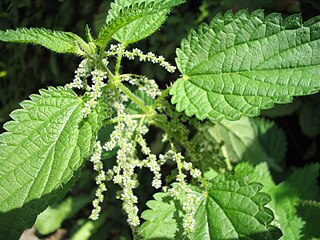
The Urticaceae are a family, the nettle family, of flowering plants. The family name comes from the genus Urtica. The Urticaceae include a number of well-known and useful plants, including nettles in the genus Urtica, ramie, māmaki, and ajlai.

Urtica is a genus of flowering plants in the family Urticaceae. Many species have stinging hairs and may be called nettles or stinging nettles, although the latter name applies particularly to Urtica dioica.
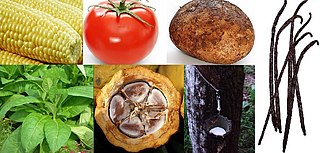
The Columbian exchange, also known as the Columbian interchange, was the widespread transfer of plants, animals, precious metals, commodities, culture, human populations, technology, diseases, and ideas between the New World in the Western Hemisphere, and the Old World (Afro-Eurasia) in the Eastern Hemisphere, in the late 15th and following centuries. It is named after the Italian explorer Christopher Columbus and is related to the European colonization and global trade following his 1492 voyage. Some of the exchanges were purposeful; some were accidental or unintended. Communicable diseases of Old World origin resulted in an 80 to 95 percent reduction in the number of Indigenous peoples of the Americas from the 15th century onwards, most severely in the Caribbean. The cultures of both hemispheres were significantly impacted by the migration of people from the Old World to the New. European colonists and enslaved Africans replaced Indigenous populations across the Americas, to varying degrees. The number of Africans taken to the New World was far greater than the number of Europeans moving to the New World in the first three centuries after Columbus.

Arracacha is a root vegetable that originates in the Andes, whose starchy taproot is a popular food item across South America where it is a major commercial crop.

Rafflesia arnoldii, the corpse flower or giant padma, is a species of flowering plant in the parasitic genus Rafflesia. It is noted for producing the largest individual flower on Earth. It has a strong and unpleasant odor of decaying flesh. It is native to the rainforests of Sumatra and Borneo. Although there are some plants with larger flowering organs like the titan arum and talipot palm, those are technically clusters of many flowers.

Corchorus is a genus of about 40–100 species of flowering plants in the family Malvaceae, native to tropical and subtropical regions throughout the world.
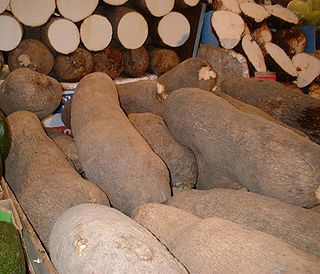
Yam is the common name for some plant species in the genus Dioscorea that form edible tubers. Yams are perennial herbaceous vines cultivated for the consumption of their starchy tubers in many temperate and tropical regions, especially in West Africa, South America and the Caribbean, Asia, and Oceania. The tubers themselves, also called "yams", come in a variety of forms owing to numerous cultivars and related species.

Parietaria judaica, with common names spreading pellitory or pellitory of the wall, is a species of herbaceous perennial plant in the family Urticaceae. The plant's pollen is highly allergenic. In Australia it is also known as asthma weed, due to the high incidence of allergy. It is unrelated to the herb pellitory. It is easily confused with the very similar species Parietaria officinalis.
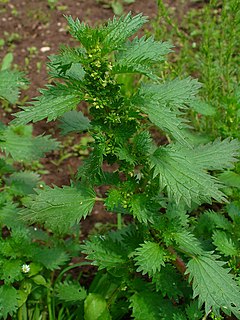
Urtica urens, commonly known as annual nettle, dwarf nettle, small nettle, dog nettle, or burning nettle, is a herbaceous annual flowering plant species in the nettle family Urticaceae. It is native to Eurasia, including the Himalayan regions of Kalimpong, Darjeeling and Sikkim in India and can be found in North America, New Zealand and South Africa as an introduced species. It is reputed to sting more strongly than common nettle.

Cassava mosaic virus is the common name used to refer to any of eleven different species of plant pathogenic virus in the genus Begomovirus. African cassava mosaic virus (ACMV), East African cassava mosaic virus (EACMV), and South African cassava mosaic virus (SACMV) are distinct species of circular single-stranded DNA viruses which are transmitted by whiteflies and primarily infect cassava plants; these have thus far only been reported from Africa. Related species of viruses are found in India and neighbouring islands, though cassava is cultivated in Latin America as well as Southeast Asia. Nine species of cassava-infecting geminiviruses have been identified between Africa and India based on genomic sequencing and phylogenetic analysis. This number is likely to grow due to a high rate of natural transformation associated with CMV.

Urera is a genus of flowering plants in the nettle family, Urticaceae. It has a pantropical distribution.

West African cuisine encompasses a diverse range of foods that are split between its 16 countries. In West Africa, many families grow and raise their own food, and within each there is a division of labor. Indigenous foods consist of a number of plant species and animals, and are important to those whose lifestyle depends on farming and hunting.

Laportea is a genus of plants in the family Urticaceae. They are herbaceous, either annual or perennial. Like many plants of the Urticaceae, they have stinging hairs. There are stinging and non-stinging hairs on the same plant. The genus was named after the French naturalist Francis de Laporte de Castelnau.
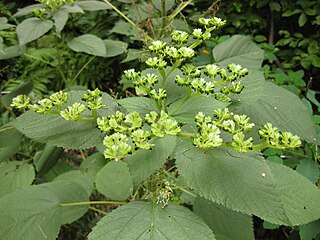
Laportea canadensis, commonly called Canada nettle or wood-nettle, is an annual or perennial herbaceous plant of the nettle family Urticaceae, native to eastern and central North America. It is found growing in open woods with moist rich soils and along streams and in drainages.
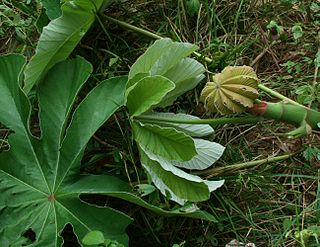
Cecropia peltata is a fast-growing tree in the genus Cecropia. Common names include trumpet tree, trumpet-bush, bacano and snakewood. It is listed as one of the world's 100 worst invasive alien species.
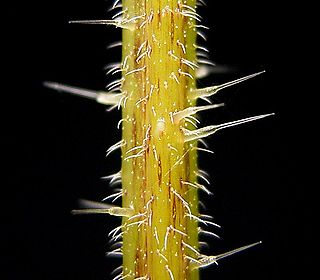
A stinging plant or a plant with stinging hairs is a plant with hairs (trichomes) on its leaves or stems that are capable of injecting substances that cause pain or irritation.

Liberian cuisine is centered on the consumption of rice, cassava, plantain, yam, tropical fruits and vegetables, as well as fish, meat, and more.

Laportea grossa, or spotted nettle, is an African plant in the family Urticaceae, and one of 31 species in the genus. This species occurs in shady places in coastal and escarpment forests, closed woodland and on streambanks from George through the Eastern Cape, KwaZulu-Natal to southern Mozambique. Young leaves of this species are cooked and eaten as a vegetable.

Dendrocnide cordifolia, commonly known as the stinging tree, is a plant in the nettle family Urticaceae endemic to the Atherton Tablelands, south west of Cairns, Queensland. Contact with the plant results in a painful sting, however the intensity and duration of the pain from this plant is extreme.




















